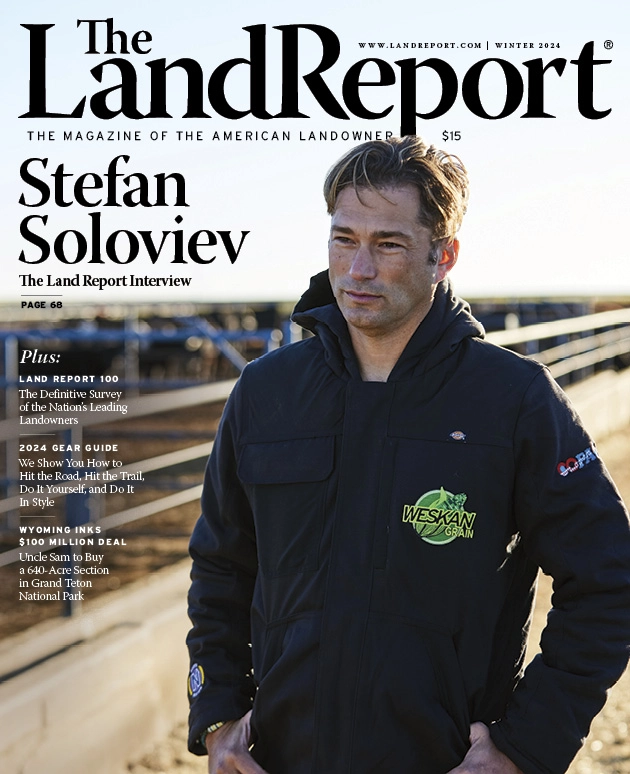Stefan Soloviev
In 2023, Soloviev purchased the LE Ranch from longtime Land Report 100er D.K. Boyd, adding 106,000 acres to his holdings in New Mexico. Large renewable-power companies, including Engie, Enel, Invenergy, NextEra, and Orsted hold leases on approximately half of Soloviev’s western lands for utility-scale wind and solar-power development. He expects to host 500 wind turbines by the end of the decade. The planning and construction of three new long-distance transmission lines across his territory has accelerated this renewable development: the Grain Belt Express by Invenergy to Chicago, Colorado’s Power Pathway by Xcel to Denver, and the SunZia Southwest Transmission Project by Pattern to California. In effect, Soloviev has become a farmer of electrons (and grain). He views renewable sources of energy and food as the ultimate form of sustainability.
Rank:
#15
Total Acres:
535,000
States:
New Mexico

Stefan Soloviev

In 2023, Soloviev purchased the LE Ranch from longtime Land Report 100er D.K. Boyd, adding 106,000 acres to his holdings in New Mexico. Large renewable-power companies, including Engie, Enel, Invenergy, NextEra, and Orsted hold leases on approximately half of Soloviev’s western lands for utility-scale wind and solar-power development. He expects to host 500 wind turbines by the end of the decade. The planning and construction of three new long-distance transmission lines across his territory has accelerated this renewable development: the Grain Belt Express by Invenergy to Chicago, Colorado’s Power Pathway by Xcel to Denver, and the SunZia Southwest Transmission Project by Pat-tern to California. In effect, Soloviev has become a farmer of electrons (and grain). He views renewable sources of energy and food as the ultimate form of sustainability.
Rank:
#21
Total Acres:
535,000
States:
New Mexico
Also in 2023, Soloviev closed on the purchase of the San Luis & Rio Grande Railroad, which he bought out of bankruptcy. The 150-mile line, which he renamed the Colorado Pacific Rio Grande Railroad, dates back to the 1870s. It joins the Colorado Pacific Railroad as Soloviev’s second short-line railroad in the Centennial State. While the original purpose of the rail line was to tap newly discovered silver and gold mines in the San Juan Mountains, the San Luis Valley now produces a different kind of gold: It’s the second-largest potato-producing territory in America. The rich farmland also provides barley to the Molson Coors brewery in Golden. All of the barley is shipped by rail on the Colorado Pacific Rio Grande Railroad. Potato and timber traffic on the railroad had shifted to highway trucking during the bankruptcy of the railroad’s previous owner, Iowa Pacific Holdings. Efforts are underway to restore the viability of rail shipping as a competitive option. Soloviev has completed construction of a grain-shuttle loading facility near Sheridan Lake, Colorado.
The facility, which is located adjacent to his Colorado Pacific Railroad, is capable of loading 100-car unit trains. There is no other location in the dryland farm country of Eastern Colorado that offers unit train availability with dual access to Union Pacific and BNSF railroads as long-haul carriers, so area farmers can now obtain more competitive freight rates to Gulf of Mexico or Pacific Northwest ports by using this facility. It has upright-concrete storage capacity of 3 million bushels and groundpile storage capacity totaling 1.8 million bushels. This year’s milo harvest was exceptional; area farmers brought so much grain to the new elevator that they filled it and the groundpile pad to capacity. Multiple-unit train shipments carried the grain to the Texas Gulf Coast for export.
— Lisa Martin
Also in 2023, Soloviev closed on the purchase of the San Luis & Rio Grande Railroad, which he bought out of bankruptcy. The 150-mile line, which he renamed the Colorado Pacific Rio Grande Railroad, dates back to the 1870s. It joins the Colorado Pacific Railroad as Soloviev’s second short-line railroad in the Centennial State. While the original purpose of the rail line was to tap newly discovered silver and gold mines in the San Juan Mountains, the San Luis Valley now produces a different kind of gold: It’s the second-largest potato-producing territory in America. The rich farmland also provides barley to the Molson Coors brewery in Golden. All of the barley is shipped by rail on the Colorado Pacific Rio Grande Railroad. Potato and timber traffic on the railroad had shifted to highway trucking during the bankruptcy of the railroad’s previous owner, Iowa Pacific Holdings. Efforts are underway to restore the viability of rail shipping as a competitive option. Soloviev has completed construction of a grain-shuttle loading facility near Sheridan Lake, Colorado. The facility, which is located adjacent to his Colorado Pacific Railroad, is capable of loading 100-car unit trains.
There is no other location in the dryland farm country of Eastern Colorado that offers unit train availability with dual access to Union Pacific and BNSF railroads as long-haul carriers, so area farmers can now obtain more competitive freight rates to Gulf of Mexico or Pacific Northwest ports by using this facility. It has upright-concrete storage capacity of 3 million bushels and groundpile storage capacity totaling 1.8 million bushels. This year’s milo harvest was exceptional; area farmers brought so much grain to the new elevator that they filled it and the groundpile pad to capacity. Multiple-unit train shipments carried the grain to the Texas Gulf Coast for export.




